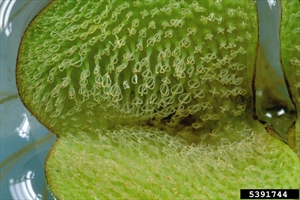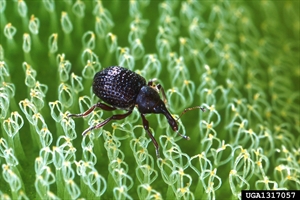- Widespread. Asia, Africa, North, South and Central America, Europe, Oceania. In Australia, Fiji, French Polynesia, New Caledonia, New Zealand, PNG, Vanuatu.
- Invasive weed of lakes, rivers, streams, rice paddies, thriving in slow-moving, nutrient-rich, warm freshwater, doubling in under 10 days, forming dense, floating mats, reducing water-flow, lowering light and oxygen levels. Impacts biodiversity (plants and fish), transport, clogs irrigation and power-generating systems, harbours mosquitoes.
- Free-floating, aquatic fern, with horizontal stems just below water. Leaves, from buds along stem. Different forms: at first, leaves, small, flat, green or yellowish-green, 2-6 cm long, with hairs aiding buoyancy; later, larger slightly folded and closer together along stems; eventually, very folded and compact. Sterile, hairy, spore sacs hang from feathery roots (modified frond), beneath water surface.
- Spread: by wind and water; floods; fur of animals; clothing; mud on vehicles, boats; garden waste; use as aquatic ornamental.
- Biosecurity: high risk of introduction via aquarium trade. In Australia, 'restricted invasive plant': do not release into environment, give away or sell. Among 100 of World's Worst Invasive Alien Species (IUCN, 2020). Available on internet.
- Biocontrol: success with weevil, Cyrtobagous salviniae, in Australia, PNG, parts of Africa.
- Cultural control: check nutrient levels (important); floating booms; manual removal or mechanical harvesting; vehicle hygiene.
- Chemical control: in Australia: glyphosate; carfentrazone-ethyl; orange oil. In Fiji, MCPA.








